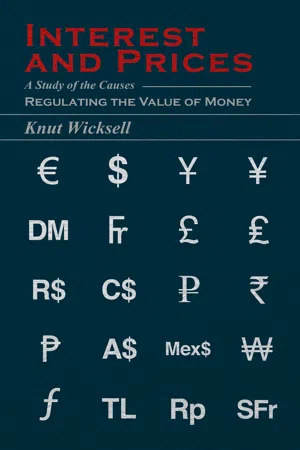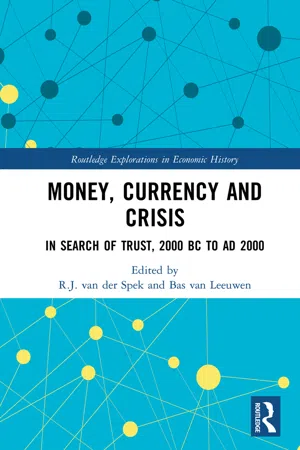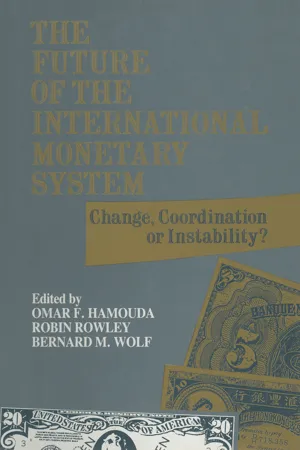Bimetallic Standard
A bimetallic standard is a monetary system where the value of the currency is based on the fixed relationship between two different metals, typically gold and silver. This system allows for the circulation of both metals as legal tender, with the value of the currency being determined by the fixed exchange rate between the two metals.
8 Key excerpts on "Bimetallic Standard"
- eBook - ePub
Money Mischief
Episodes in Monetary History
- Milton Friedman(Author)
- 1994(Publication Date)
- Mariner Books(Publisher)
...Chapter 6 Bimetallism Revisited * Throughout recorded history, monetary systems have generally been based on a physical commodity. Metals have been the most widely used, the precious metals of silver and gold above all. As between them, “silver composed nearly the entire circulating metallic currency of Europe” until at least the late nineteenth century (Martin 1977, p. 642), and also of India and other parts of Asia. Gold was used much less, primarily for high-valued transactions. The rate of exchange between silver and gold was sometimes specified by the authorities, sometimes left to the market. If a legal rate was specified, the result was a bimetallic system (as described in chapter 3) under which an authorized mint stood ready, for anyone who requested it to do so, to turn either silver or gold into coins of designated face value and specified weight and fineness on demand (free coinage). Typically there was a small seignorage charge to cover the cost of minting, though sometimes, as in Great Britain and the United States, there was none. The legal price ratio was determined by the weights assigned to the silver and gold coins. For example, from 1837 to the Civil War, the U.S. gold dollar was defined as equal to 23.22 grains of pure gold, the silver dollar as equal to 371.25 grains of pure silver—or 15.988 times as many grains of silver as of gold, rounded in common parlance to a ratio of 16 to 1. A strictly equivalent way to define a Bimetallic Standard is in terms of a government commitment to buy either gold or silver at a fixed price in money designated as legal tender. For the U.S. example, the corresponding fixed prices were $20.67 per fine ounce of gold and $1.29 per fine ounce of silver. * That remained the legal price of gold until 1933, when President Franklin D. Roosevelt raised it by stages and then fixed it at $35 an ounce in early 1934. There it remained until it was raised to $42.22 in early 1973, the price at which the gold holdings of the U.S...
- eBook - ePub
- John Roscoe Turner(Author)
- 2019(Publication Date)
- Routledge(Publisher)
...Should either metal become cheaper debtors will be eager to pay with it. This will at once increase the demand for the cheaper and lower the demand for the dearer metal, thereby making them equal. 5. Bimetallism means the free coinage of two metals at a fixed ratio, the coins of either being legal tender as the debtor may elect. Monometallism is a monetary system where one metal is given the right of free coinage. Bimetallism as well as monometallism may be thought of as a single standard. Two metals maintained at a parity perform precisely the same functions; they lose their independence in a monetary sense and become one and the same. A country may have the Bimetallic Standard based on gold and silver, and coin other metals, as copper and nickel. Coins of other metals, however, are token and not primary money. The common man of this generation thinks of bimetallism as a mere theory—-something nice to talk about but dangerous and unworkable if established. He is not informed that mankind has had far more experience and, may I add, more satisfactory experience with bimetallism than with monometallism and that prior to the nineteenth century no nation definitely adopted monometallism, England broke the rule in 1816, but neither the United States nor European nations followed her example until after 1870. Bimetallism is workable and it is not involved in mystery as many are led to believe. It rests upon a single definite and simple principle which explains the extraordinary permanence of the ratio of exchange of gold and silver under bimetallism. 6. The compensatory principle is the fundamental fact In bimetallism. This principle recognizes two great demands for both gold and silver; their use in the arts and in the coinage of money. The monetary demand is large and any change in it reacts quickly upon the purchasing power of these metals...
- Knut Wicksell(Author)
- 2011(Publication Date)
- Josephs Press(Publisher)
...We are told that if two commodities are employed as a measure of prices, their value in conjunction must be more stable than of either taken separately. That may be true, but it is improper to proceed by way of the “Law of Large Numbers” when it is a question purely of the transition from the number one to the number two. Circumstances can easily arise under which the Bimetallic Standard of prices would be less stable than gold. Let us imagine—what is, after all, not unthinkable—that we have now reached the lowest point of the downward movement of prices, and that the continual production of gold and the excess of bank reserves must necessarily tend to depress the money rate of interest and force up prices. In the immediate future, however, fairly stable prices might be attained, inasmuch as new countries, such as Austria, Russia, 1 and perhaps finally India, may turn over to gold coinage. But the introduction of bimetallism, even at a moderate ratio, would under such conditions bring about a continual, and perhaps very considerable, rise in prices, with all the associated disadvantages. The same essential considerations apply to the “composite standard” or “symmetalism” proposed by Marshall, Edgeworth, and others. Under this system, a country’s, or the world’s, coinage would consist of a mixture in certain proportions of gold and silver. The system would not even have the merit of avoiding fluctuations in the rate of foreign exchange with silver countries. L. Walras has proposed a method, 2 not really bimetallism at all, which theoretically is less objectionable. He would maintain the use of gold as a standard, and he would not permit the free coinage of silver; but silver is to be used as a billon régulateur, the size of the stock of monetary silver being managed according to circumstances, with the object of achieving the highest possible degree of constancy of the value of money in terms of commodities...
- eBook - ePub
Gold and the Gold Standard
The Story of Gold Money, Past, Present and Future
- Dr. Edwin Walter Kemmerer(Author)
- 2018(Publication Date)
- Papamoa Press(Publisher)
...They argued that the shift of many leading countries of the world to the gold standard from bimetallism since the early seventies had placed an increasingly heavy monetary demand on gold, while greatly decreasing the monetary demand for silver and destroying its erstwhile unlimited market at the mints. The resulting decline in commodity prices in gold-standard countries, they held, was having many harmful effects, among which they stressed the following. Falling prices, so they said, meant an increasing value or purchasing power of the money unit in which all debts were payable, and this imposed a continually increasing burden upon the debtor classes, particularly the farmers, who were receiving progressively lower prices for their products and paying their mortgage debts in a dollar of ever-increasing value. Continually falling prices, they further pointed out, exercised a depressing influence on business, causing unemployment and financial crises, and they argued that the readoption of bimetallism would, by bringing silver to the assistance of gold as a standard money metal, increase the money supply and thereby stop falling prices. Another argument advanced by bimetallists against the substitution of gold monometallism for bimetallism was that it had broken down the so-called nexus between countries on different metallic money standards. As long as some countries were on a Bimetallic Standard, with the unlimited coinage of both gold and silver at a fixed mint ratio, the fluctuation would be very slight in the gold price of silver in gold-standard countries and in the silver price of gold in silver-standard countries. Foreign exchange rates, therefore, among countries on all three standards—bimetallic, gold, and silver—would be stable, as they were prior to 1873. Since discontinuance of bimetallism, it was said, all this had been changed. The nexus between gold and silver was broken and each metal had gone its own way...
- eBook - ePub
Money, Currency and Crisis
In Search of Trust, 2000 BC to AD 2000
- R.J. van der Spek, Bas van Leeuwen, R.J. van der Spek, Bas van Leeuwen(Authors)
- 2018(Publication Date)
- Routledge(Publisher)
...The solution, the ‘mode’, was found by issuing silver coins at a premium over their metal content, that is, with a face value higher than their intrinsic silver value. These coins had a limited legal tender and controlled supply, and silver was effectively reduced to a subsidiary role. The potential instability of a Bimetallic Standard did not deter the imaginative mind of Irving Fisher from going beyond that, or any metallic standard, at the same time revealing what he called the ‘money illusion’, the idea that gold (or silver) can be an anchor of stability. Writing in the post-World War I years, he observes a notable increase in the price level, even though the United States is on the gold standard. This means a reduction of the purchasing power of the dollar, that is – if the dollar is defined by a certain gold content – a reduction of the gold price in terms of goods to be purchased. He paradoxically writes that to link the dollar to an alloy of gold and silver would be a better solution, because their divergent movements (which, as we have seen, had brought the demise of bimetallism) might compensate for each other. Still better, however, would be to enlarge the basket of metals that would back the dollar or, by the same token, to adopt the widest possible basket of goods and commodities, and to state by law that ‘the dollar represents a composite of those very goods in general’. A general price index would secure a dollar constant in purchasing power. The gold dollar would remain, but it would correspond in value to a ‘composite goods-dollar’, that is, it would be equivalent to such a market-based dollar. In this way, gold would continue being a medium of exchange, but not a standard of value. In order to reach this result – Fisher writes – we should vary at short intervals the gold content of the dollar (its gold weight)...
- eBook - ePub
The Future of the International Monetary System
Change, Coordination of Instability?
- Omar F. Hamouda, Robin Rowley, Bernard M. Wolf(Authors)
- 2016(Publication Date)
- Routledge(Publisher)
...15 A neglected monetary standard alternative: gold/commodity bimetallism Albert Gailord Hart Most economists will probably agree with McKinnon (Journal of Economic Literature, 1988): Without a common monetary standard, the remarkable integration of Western European, North American, and the industrialized Asian economies in both commodity trade and financial flows is less efficient, and becoming untenable. Dissatisfaction with wildly fluctuating relative currency values, euphemistically called 'floating' or 'flexible' exchange rates, is a prime cause of the resurgence in protectionism. If we agree that the lack of a monetary standard must be made good, we are still far from agreeing about what the standard should be – or even what it is likely to do for the world economy. What the world needs from a new monetary standard is above all a foundation for expectations of stability. On the foreign-exchange markets as on the stock markets, the horizon of forward-thinking has become shorter and shorter. As McKinnon points out, we have got into a position where purchasing-power-parity considerations seem irrelevant to the processes that move the relative prices of currencies, although the relative values of currencies become more and more relevant to decisions on trade and on investment in new productive facilities! To recreate a context in which expectations are focused by belief in a norm, we must recognize the pivotal importance of the link between the monetary standard and the 'real' goods and service economy...
- eBook - ePub
- Léon Walras, William Jaffé(Authors)
- 2013(Publication Date)
- Routledge(Publisher)
...Lesson 31 THE ESTABLISHMENT OF THE VALUE OF A Bimetallic Standard 284. The controversy between monometallists and bimetallists offers a striking example of the confusion of issues which befogs the argument simply for want of applying the only suitable method to the analysis of essentially quantitative phenomena. Given the will to do so, it is perfectly possible to demonstrate these fundamental questions with mathematical rigour. In the preceding Lesson, I have shown that if only one commodity (A) is used as money, there are exactly three equations indicating (1) that the sum of the quantities of (A) in both commodity and monetary uses is equal to the total quantity of (A); (2) how the price of (A) in commodity use depends on the quantity of (A) in that use; and (3) how the price of (A) in monetary use depends on the quantity of (A) in that use, to determine the three unknowns, viz. (1) the quantity of (A) remaining in commodity use; (2) the quantity of (A) converted into money; (3) the price common to (A) in both commodity and monetary uses expressed in terms of some other commodity. If, now, two commodities (A) and (O) are used concurrently as money there would be no more than five equations indicating (1) that the sum of the quantities of (A) in commodity and monetary uses is equal to the total quantity of (A); (2) that the sum of the quantities of (O) in commodity and monetary uses is equal to the total quantity of (O); (3) how the price of (A) in commodity use depends on the quantity of (A) so used; (4) how the price of (O) in commodity use depends on the quantity of (O) so used; (5) how the price of (A) in monetary use and the price of (O) in monetary use both depend on the quantity of (A) and the quantity of (O) in that use, to determine the six unknowns, viz. (1) the quantity of (A) in commodity use; (2) the quantity...
- John Stuart Mill(Author)
- 2017(Publication Date)
- Madison & Adams Press(Publisher)
...3. The experience of the United States with a double standard from 1792 to 1883 Table of Contents The experience of the United States with a double standard, extending as it does from 1792 to 1873 without a break, and from 1878 to the present time, is a most valuable source of instruction in regard to the practical working of bimetallism. While we have nominally had a double standard, in reality we have either had one alone, or been in a transition from one to the other standard; and the history of our coinage strikingly illustrates the truth that the natural values of the two metals, in spite of all legislation, so vary relatively to each other that a constant ratio can not be maintained for any length of time; and that “the poor money drives out the good,” according to Gresham's statement. For clearness, the period may be divided, in accordance with the changes of legislation, into four divisions: I. 1792-1834. Transition from gold to silver. II. 1834-1853. Transition from silver to gold. III. 1853-1878. Single gold currency (except 1862-1879, the paper period). IV. 1878-1884. Transition from gold to silver. I. With the establishment of the mint, Hamilton agreed upon the use of both gold and silver in our money, at a ratio of 15 to 1: that is, that the amount of pure silver in a dollar should be fifteen times the weight of gold in a dollar. So, while the various Spanish dollars then in circulation in the United States seemed to contain on the average about 371-¼ grains of pure silver, and since Hamilton believed the relative market value of gold and silver to be about 1 to 15, he put 1/15 of 371-¼ grains, or 24-¾ grains of pure gold, into the gold dollar. It was the best possible example of the bimetallic system to be found, and the mint ratio was intended to conform to the market ratio. If this conformity could have been maintained, there would have been no disturbance...







